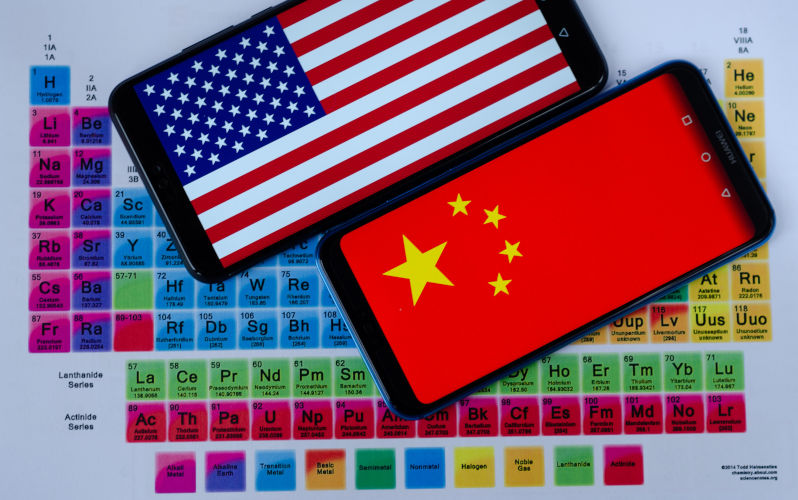China-US critical minerals war an opportunity for Australia to get smart
October 21, 2025
As the Trump administration deepens its tariff trade war with China, the latter has placed fresh curbs on exports to the US of the rare earths and critical minerals indispensable to the production of clean energy tech, as well as defence, computing and AI capabilities.
China controls 80-90% of the global supply, holding vast reserves and dominates processing after investing early and strategically. But Australia has major skin in this game too. We have the world’s largest supply of lithium and abundant reserves of cobalt, nickel, manganese, graphite and rare earths. Currently, our biggest customer is our #1 trade partner, with 90% of our lithium going to China.
Now, Australia is being courted by the US as a potential key strategic partner in diversifying and securing its supply against the escalating backdrop of China-US tensions and retaliatory trade restrictions. Diversification of critical mineral supply chains will be high on the agenda in talks between Prime Minister Albanese and President Trump this week.
Negotiating our way between our biggest customer — the globally dominant force in all zero emissions technologies and industries of the future — and our traditional security ally is fraught. Trump has forced the world to think very differently about the now strategically-challenged concepts of old, about the workings of a free market capitalist global trade system with respect to the energy transformation and geopolitics.
The playing field is being reshaped by megatrends such as the US walking away from global free trade and turning to protectionism, and escalating climate change. The rise and rise and rise of China is a defining feature of our age, now playing out in its extraordinary efforts to decarbonise and the epic battle to control the resource supply chains that will determine geopolitical supremacy in the decades ahead. China, of course, does not operate on the Western capitalist free markets model, but invests strategically in its own long-term national interest – as it has done in establishing overwhelming global dominance in critical minerals refining onshore.
A savvy geopolitical lens is required to navigate these shifting trade, energy and national security dynamics, with a contemporary view of the new world order that serves our national economic interest. In the minerals trade, currently we ship mostly raw rocks, failing to capitalise on the opportunity to substantially increase the value of our exports, a pattern that sees us languishing at a shocking 105 out of 145 nations on the Harvard Economic Complexity Index, having slipped from the 60s two decades ago.
A critical and urgent priority should be to position Australia as more than a quarry, leveraging our natural advantages to move up the global value chain by expanding onshore processing and refining capacity, capturing the resulting geostrategic advantages, supply certainty and economic returns key to our future prosperity and energy and national security.
In April, the Albanese Government created a Critical Minerals Strategic Reserve with an initial $1.2 billion investment; A$200 million for operation, funding and stockpiling and A$1 billion of capital to invest. This remains in the design phase and will not be operational until the second half of 2026. The reserve builds on the A$4 billion Critical Minerals Facility, boosted to A$5 billion in April 2025, a loan program administered by Export Finance Australia. One of the first investments was A$400 million in loans to Alpha HPA to process ultra high-purity alumina (used in semiconductors and lithium batteries) in Queensland. Other support includes a A$185 million loan to Renascor Resources to fast track its Siviour Graphite Project in South Australia and packages of A$1.65 billion and A$800 million to rare earth producers Iluka Resources WA and Arafura Resources NT respectively.
This is commendable, but there is significant opportunity for Canberra to go further. Albanese should review the MP Materials deal, which saw the Pentagon invest US$400 million in the US rare earths miner at the same time as providing a guarantee of a 10-year offtake agreement at a price double the then market rate.
The idea of leaving rare earths trade to a free market, when the “free market” is a tiny fraction of the game, is flawed, and demonstrably outmoded in the above context. Our Critical Minerals Strategic Reserve should be deployed to provide price guarantees for producers as part of the government’s plan, and there is strong speculation that this is under consideration.
However, in our view a price floor should form part of a strategic, integrated and mission-led approach to managing Australia’s green industrial transition coordinated at the highest levels of government – “Green Energy Statecraft”. This should include a Clean Commodities Trading Initiative as proposed by Elizabeth Thurbon. The government backed CCTI would support early-stage market formation by contracting for supply of value-added products like refined minerals and green iron, then selling, holding, or redistributing clean commodities as markets evolve. This would help de-risk early investment — including in onshore processing — by strategically deploying the government’s balance sheet to provide price and offtake certainty to underwrite value-adding investments and crowd-in private capital.
The current superpower showdown puts Australia in something of a box seat. Let’s be smart about it, and grasp this exceptional opportunity to take a more sophisticated approach to energy and commodities diplomacy that moves us from a “dig and ship” backwater to a key player in the emerging net zero global economy. We need to move fast, or be left behind. If not now, when?
The views expressed in this article may or may not reflect those of Pearls and Irritations.
